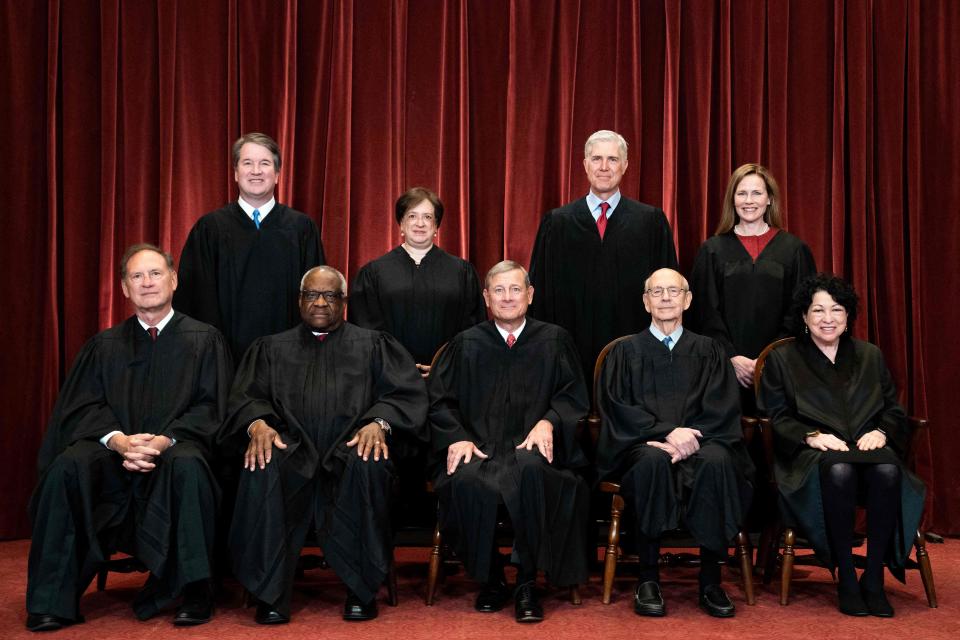Don't blame Supreme Court justices for behaving as expected. Change how they are chosen.
It was ironic Thursday that as the Supreme Court was handcuffing the Environmental Protection Agency's effort to address climate change, President Joe Biden was in Madrid slamming the court for its decision last week handcuffing women seeking abortions.
The two rulings, along with another handcuffing states that want to keep guns off the streets, highlighted a term defined by the court’s fledgling 6-3 conservative majority. Only two significant rulings went liberals’ way; both targeted former President Donald Trump, whose three high court nominees have upset a relative balance that had served America well.
The nation's political branches are trouble enough. When they are at loggerheads and unable to function, the legal branch should be counted on for stability. Instead, as Biden pronounced across the Atlantic, its most notorious decision on abortion was "destabilizing."
Supreme injustice: I grew up near a coal power plant. This EPA decision will worsen public health inequity.
But don't blame the individual justices for the mess they have created. Each one is behaving as expected. We can't ask a conservative originalist to view the Constitution as ever changing, just as we can't expect a liberal to adhere to the framers' 235-year-old views.
How did we get to this place?
The problem is the way in which the court's members are chosen. Whereas the House of Representatives is up for grabs every two years, the White House every four and the Senate every six, Supreme Court vacancies are dependent on the health and happiness of the justices themselves. When they choose to leave – or, in the recent case of liberal Justice Ruth Bader Ginsburg, die while on the bench – the party with the upper hand benefits.
A political High Court: This Supreme Court, built by politics, doesn't deserve to rule on Roe v. Wade
We are at this place because President George H.W. Bush was in office when liberal Justice Thurgood Marshall, in failing health, retired and was replaced by Clarence Thomas, now the court’s most conservative member. We are here because Republican presidents got to name Samuel Alito, Brett Kavanaugh and Amy Coney Barrett as replacements for less conservative justices. And we are here because Republican senators unfairly held the late Justice Antonin Scalia's seat open until the GOP won the White House.
But the opposite set of circumstances could have created a liberal court, one that would not reflect America any better than this one. Looking ahead, if Democrats control the White House and Senate when, say, septuagenarians Thomas and Alito depart, what goes around will have come around.

The Supreme Court needs a structural fix. Adding more justices, as progressives want, isn’t the solution. For one thing, it’s unlikely to happen. For another, it would trigger similar gamesmanship when conservatives are in power, further destabilizing the branch that should save us from the others.
Term limits are an imperfect alternative, but they represent the best hope. If every new justice could serve only 18 years, then eventually a vacancy would occur every two years. Voters could take that into consideration at election time. The winning political parties would win Supreme Court seats, rather than it being left to haphazardly timed illnesses and deaths.
This would also stop justices, no matter how talented they may be, from sticking around long into their 70s and 80s. And it would remove the incentive for presidents to choose replacements in their 40s based on actuarial tables as much as talent.
Value the Constitution?: Then you must be fine with Supreme Court nixing gun law
It’s questionable whether term limits could be imposed by Congress or would require a constitutional amendment. In either case, unfortunately, it's a long shot. So what should be done in the meantime?
Democrats should stop grousing about how Republicans, led by Senate GOP leader Mitch McConnell, have manipulated the system and get even, not by packing the court but by winning elections. Warning voters that Republican victories could produce an even more lopsided court for decades to come sounds like a winning issue. Elect Democrats to the White House and Senate, they should say, in order to create a court that better reflects America.
Now is the time to talk term limits
A couple of hours after the justices issued a 6-3 ruling to limit the EPA’s ability to regulate carbon emissions from existing power plants – and thereby battle climate change – the court became a bit more representative with the ascension of Justice Ketanji Brown Jackson, the nation’s first Black female justice.
Jackson’s swearing-in ceremony followed the retirement of 83-year-old Justice Stephen Breyer, who did what Ginsburg failed to do during Barack Obama’s presidency by stepping down when a like-minded successor could have been seated.
Justice Jackson: Black female strength tells an all-American story

It is a sad epilogue to Ginsburg’s illustrious career as a crusading women’s rights attorney, federal appeals court judge and Supreme Court justice that she ultimately served too long and passed away while Donald Trump was in office. Her death, like Marshall’s illness 31 years ago, led us to this unfortunate situation.
Now is the time to make the Supreme Court less destabilizing by starting down the path toward predictable turnover. The alternative is to continue choosing our political leaders every two, four and six years while leaving the makeup of the nation’s highest court subject to chance.
Richard Wolf reported on the Supreme Court, the White House and Congress during a 45-year career in journalism. Follow him on Twitter: @richardjwolf
You can read diverse opinions from our Board of Contributors and other writers on the Opinion front page, on Twitter @usatodayopinion and in our daily Opinion newsletter. To respond to a column, submit a comment to letters@usatoday.com.
This article originally appeared on USA TODAY: Term limits can bring balance back to a 'destabilizing' Supreme Court

 Yahoo Movies
Yahoo Movies 
